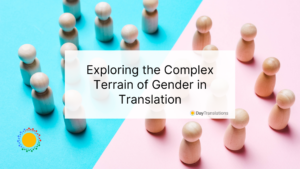Cultural back-translation isn’t just a nice-to-have—it’s a marketing campaign’s secret weapon. When brands go global, the stakes are massive: your slogan could inspire loyalty or ignite controversy. You’re playing on a field where every word, every nuance, and every cultural cue matters.
By flipping the script—literally—this method doesn’t just expose errors; it puts your entire campaign under a microscope, ensuring nothing gets lost in translation. With that in mind, let’s take a deeper dive into this lesser-known approach to localized marketing campaigns.
The Importance of Cultural Sensitivity in Marketing
Marketing campaigns are not just about conveying information; they’re about creating emotional connections. A well-localized campaign takes into account linguistic nuances, idiomatic expressions, and cultural contexts.
Without proper localization, even the most well-meaning slogans or advertisements can become offensive or meaningless in a different cultural setting. Back-translation ensures that these localized elements align with the original intent, serving as a safety net for spotting errors or misinterpretations.
Take, for example, an international brand launching a campaign in a region where cultural norms differ significantly from the source market. Back-translation can allow localization managers to reveal whether the adaptation not only retains the intended meaning but also respects cultural sensitivities.
This process ensures the content avoids missteps that could lead to reputational damage or alienate the target audience. It’s not just important—it’s crucial to convey the right message across.
The Role of Back-Translation in Quality Assurance
The essence of back-translation lies in its ability to expose discrepancies between the original and the translated content. Think of it as a comprehensive review that is particularly effective in identifying and addressing several critical issues:
- Mistranslations: Literal translations often result in altered meanings that stray from the original intent. For example, idiomatic expressions or figurative language might be translated word-for-word, losing their impact or leading to misunderstandings. Back-translation helps identify such errors, ensuring the message retains its intended clarity and tone.
- Cultural misalignments: Cultural nuances are integral to marketing success. A phrase or symbol that works well in one culture could offend or confuse another. One example of cultural misalignment is Pepsi’s slogan in the 1960s: “Come alive with the Pepsi Generation.” When translated into Mandarin for the Chinese market, it was interpreted as “Pepsi brings your ancestors back from the grave.”
- Missing context: Subtleties in meaning can be lost when context is not carried over during the translation process. This often happens with industry-specific jargon, metaphors, or references unique to the source language. Through a comparison of the back-translated text with the original, linguists can restore these missing layers of meaning, ensuring the final version is both accurate and comprehensive.
In practice, back-translation involves iterative comparisons between the translated and source texts. Each discrepancy is analyzed collaboratively by project managers and linguists to refine the output.
Integrating Localization Strategies
Back-translation is not a standalone process; it’s part of a larger localization strategy. Effective localization involves adapting content to align with the linguistic and cultural expectations of the target market. In particular, imagery, color schemes, and even product names may require adjustments to resonate with local consumers.
For example, the number 8 is regarded as extremely lucky in China because its pronunciation (“ba”) sounds similar to the word for wealth or prosperity (“fa”). Brands may incorporate the number 8 into product pricing, promotional codes, or even launch dates.
In this regard, launching a product on August 8th (8/8) or pricing an item at ¥88 aligns with this belief and enhances appeal to the local market. You might have also noticed a lot of gambling sites targeting the Chinese market have the “888” as part of their brand name.
In marketing campaigns, localization ensures that cultural touchpoints are preserved or adapted appropriately. For example, a financial services campaign targeting a global audience may use back-translation to confirm that intricate financial terminology—like interest rates or bank statement reconciliation—is accurately translated while remaining culturally and contextually relevant.
Given the complexity of financial translation, this extra layer of verification is crucial to avoid miscommunication that could lead to legal or financial repercussions.
Leveraging Tech for Better Back Translation
While back-translation will forever require the watchful eye of an expert translator or linguist, we can’t deny the benefits of automation.
Believe it or not, programming languages like Python can be used to handle basic translation tasks, such as automating terminology checks or analyzing large volumes of text for consistency. You can even use C# to convert entire documents, depending on your or your team’s tech literacy level. Tools like these are particularly useful in back-translation workflows, where ensuring consistency across multiple iterations is critical.
Likewise, custom scripts can be designed to flag discrepancies between the back-translation and the original text, streamlining the review process. If you manage to develop a system and integrate it into the quality assurance pipeline, teams can improve accuracy and save time while focusing on the more nuanced aspects of translation, such as cultural adaptation.
Expanding the Role of AI in Back-Translation
In addition to more traditional means of automation, AI is also revolutionizing back-translation workflows, making them more efficient and accurate.
Machine learning models can process vast amounts of data, identifying patterns and inconsistencies in translations that might escape human reviewers. AI-driven tools can also simulate cultural and contextual nuances, providing a deeper layer of quality assurance.
For example, neural machine translation models can perform preliminary back-translations, flagging potential mismatches for human reviewers to address. This integration of AI allows linguists to focus on refining cultural nuances while automating most of the ‘grunt work.’
Again, while AI cannot replace human expertise, it complements the process by automating repetitive tasks and enhancing precision.
Challenges and Limitations of Back-Translation
While back-translation is a valuable tool, it is not without its limitations. One of the primary challenges lies in the potential for over-reliance. It’s incredibly easy to second-guess everything, which can lead to even more mistakes.
Back-translation is a diagnostic tool, not a definitive solution. It highlights areas of concern but requires skilled linguists and cultural experts to interpret and resolve these issues. In particular, solving the problem is much more difficult than merely ‘diagnosing’ it.
Additionally, back-translation is notorious for being resource-intensive. For large-scale marketing campaigns, involving multiple languages and dialects, the process can become complex and time-consuming. This can be especially daunting if a campaign spans across multiple contents and requires
Conclusion
Cultural back-translation is more than a linguistic exercise; it’s a critical component of quality assurance in global marketing.
Through the ability to reveal discrepancies, ensure cultural alignment, and enhance localization efforts, back-translation empowers brands to connect authentically with diverse audiences.
When integrated with technology and supported by skilled professionals, it becomes an indispensable tool for navigating the complexities of international marketing campaigns. It’s an indispensable part of the modern translator’s arsenal.
Author Bio:
Nahla Davies
Author and Editor of NahlaWrites.com












Sorry, the comment form is closed at this time.